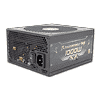 0
0
Thortech Thunderbolt Plus 1000 W Review
Ripple Measurements »Advanced Transient Response Tests
In these tests we monitor the response of the PSU in two different scenarios. First a transient load (11A at +12V, 5A at 5V, 6A at 3.3V and 0.5A at 5VSB) is applied for 50 ms to the PSU, while the latter is working at a 20% load state. In the second scenario the PSU, while working with 50% load, is hit by the same transient load. In both tests, we measure the voltage drops that the transient load causes, using our oscilloscope. In any case voltages should remain within the regulation limits specified by the ATX specification. We must stress here, that the above tests are crucial, since they simulate transient loads that a PSU is very likely to handle (e.g. starting of a RAID array, an instant 100% load of CPU/VGAs etc.) We call these tests “Advanced Transient Response Tests” and they are designed to be very tough to master, especially for PSUs with capacities lower than 500W.
| Advanced Transient Response 20% | ||||
|---|---|---|---|---|
| Voltage | Before | After | Change | Pass/Fail |
| 12 V | 12.125V | 12.014V | 0.92% | Pass |
| 5 V | 5.129V | 5.003V | 2.46% | Pass |
| 3.3 V | 3.354V | 3.237V | 3.49% | Pass |
| 5VSB | 5.118V | 5.049V | 1.35% | Pass |

| Advanced Transient Response 50% | ||||
|---|---|---|---|---|
| Voltage | Before | After | Change | Pass/Fail |
| 12 V | 12.035V | 11.923V | 0.93% | Pass |
| 5 V | 5.082V | 4.968V | 2.24% | Pass |
| 3.3 V | 3.300V | 3.183V | 3.55% | Pass |
| 5VSB | 5.091V | 5.023V | 1.33% | Pass |
In all tests voltage drops are low, so the registered variations are away from the 5% limit. The +12V rail, the most important of all and the one that will have to handle the heaviest dynamic loads in a system, registered under 1% deviation at both tests. This is not the lowest we have seen of course, by a high capacity unit, but still is good enough.
Below you will find the oscilloscope screenshots that we took during Advanced Transient Response Testing.
Transient Response at 20% Load
Transient Response at 50% Load
Turn-On Transient Tests
In the next set of tests we measure the response of the PSU in simpler scenarios of transient loads, during the turn on phase of the PSU. In the first test we turn off the PSU, dial 2A load at 5VSB and then switch on the PSU. In the second test, while the PSU is in standby, we dial the maximum load that +12V can handle and we start the PSU. In the last test, while the PSU is completely switched off (we cut off power or switch off the PSU's On/Off switch), we dial the maximum load that +12V can handle and then we switch on the PSU from the loader and we restore power. The ATX specification states that recorded spikes on all rails should not exceed 10% of their nominal values (e.g. +10% for 12V is 13.2V and for 5V is 5.5V).In these tests some noticeable voltage overshoots were recorded, but thankfully these were not close to the corresponding limits. At 5VSB the spike reached 5.3V while on the +12V rail, in worst case scenario, it reached 12.6V, a high reading but still far away from the limit (13.2V). Overall we can't say that the unit impressed us with its performance here since we expected much smaller or no spikes, a scenario that was usually the case for most of the high-end units we have reviewed in the past.
Apr 3rd, 2025 23:22 EDT
change timezone
Latest GPU Drivers
New Forum Posts
- 4x16gb how are these? (21)
- AAF Optimus Modded Driver For Windows 10 & Windows 11 - Only for Realtek HDAUDIO Chips (386)
- Is RX 9070 VRAM temperature regular value or hotspot? (309)
- Windows 11 General Discussion (5921)
- What's your latest tech purchase? (23462)
- RX 9000 series GPU Owners Club (128)
- Someone knowledable on memory voltages want to chime in? (also what is PMIC and should I be worried) (31)
- Mllse 6600s that are locked at 500 mhz. (6)
- A Final Fantasy IX Reminiscence - My love letter and homage to one of the best stories ever told (87)
- ROG-STRIX-LC-RX6900XT-O16G-GAMING (7)
Popular Reviews
- DDR5 CUDIMM Explained & Benched - The New Memory Standard
- PowerColor Radeon RX 9070 Hellhound Review
- Sapphire Radeon RX 9070 XT Pulse Review
- Pwnage Trinity CF Review
- Corsair RM750x Shift 750 W Review
- Sapphire Radeon RX 9070 XT Nitro+ Review - Beating NVIDIA
- SilverStone Lucid 04 Review
- Upcoming Hardware Launches 2025 (Updated Apr 2025)
- Palit GeForce RTX 5070 GamingPro OC Review
- AMD Ryzen 7 9800X3D Review - The Best Gaming Processor
Controversial News Posts
- MSI Doesn't Plan Radeon RX 9000 Series GPUs, Skips AMD RDNA 4 Generation Entirely (146)
- Microsoft Introduces Copilot for Gaming (124)
- AMD Radeon RX 9070 XT Reportedly Outperforms RTX 5080 Through Undervolting (119)
- NVIDIA Reportedly Prepares GeForce RTX 5060 and RTX 5060 Ti Unveil Tomorrow (115)
- Over 200,000 Sold Radeon RX 9070 and RX 9070 XT GPUs? AMD Says No Number was Given (100)
- NVIDIA GeForce RTX 5050, RTX 5060, and RTX 5060 Ti Specifications Leak (96)
- Retailers Anticipate Increased Radeon RX 9070 Series Prices, After Initial Shipments of "MSRP" Models (90)
- Nintendo Switch 2 Launches June 5 at $449.99 with New Hardware and Games (89)










